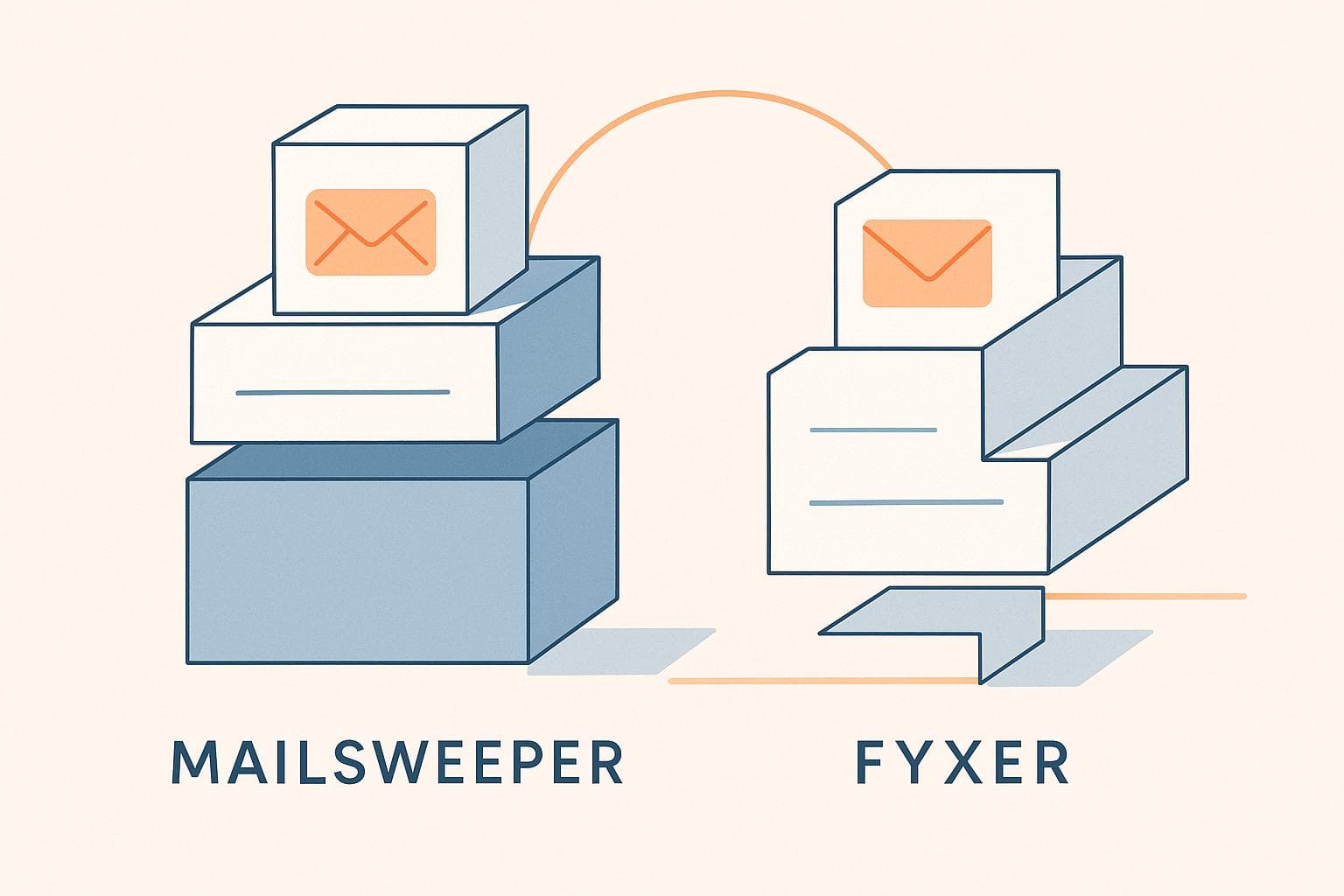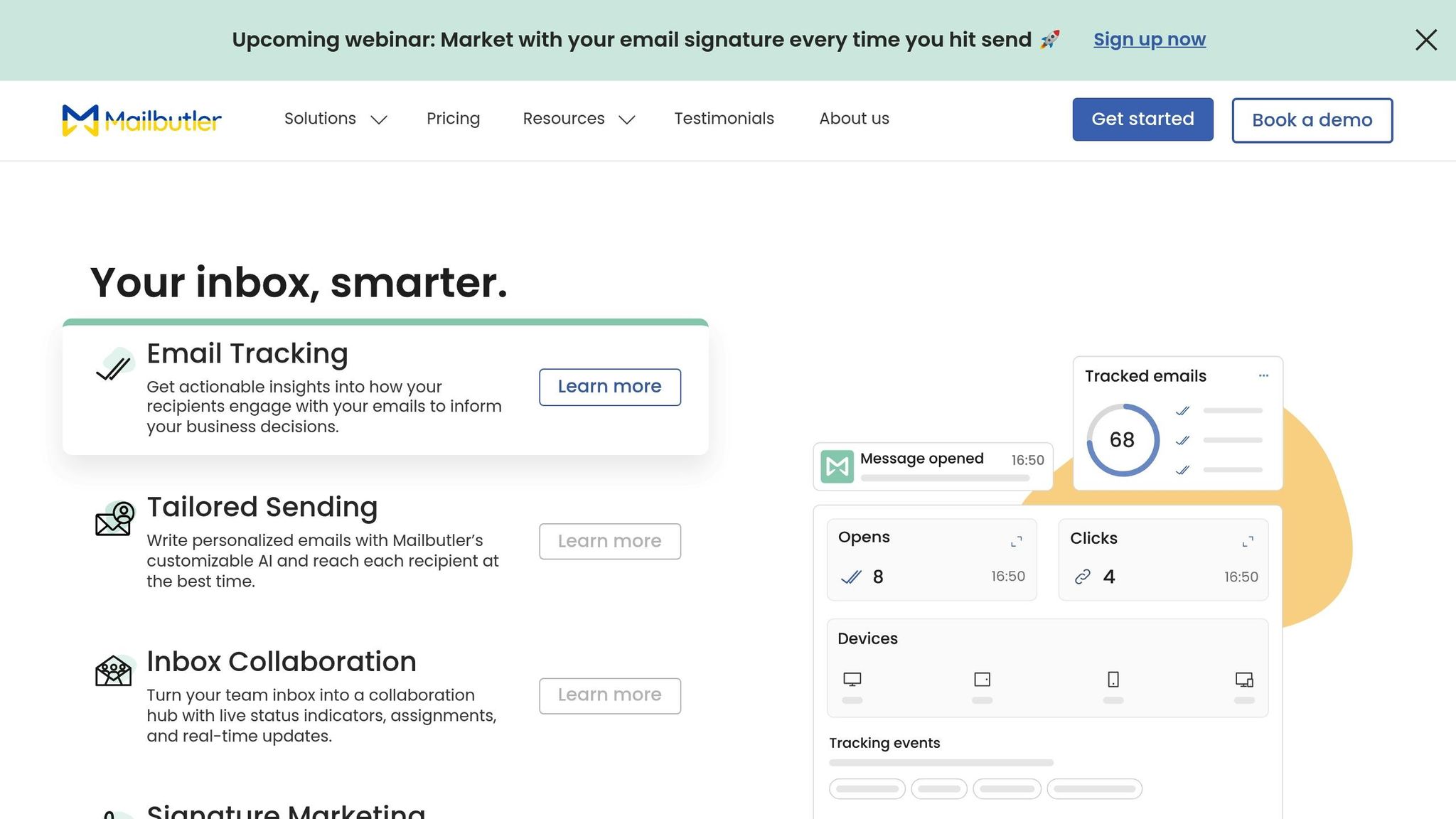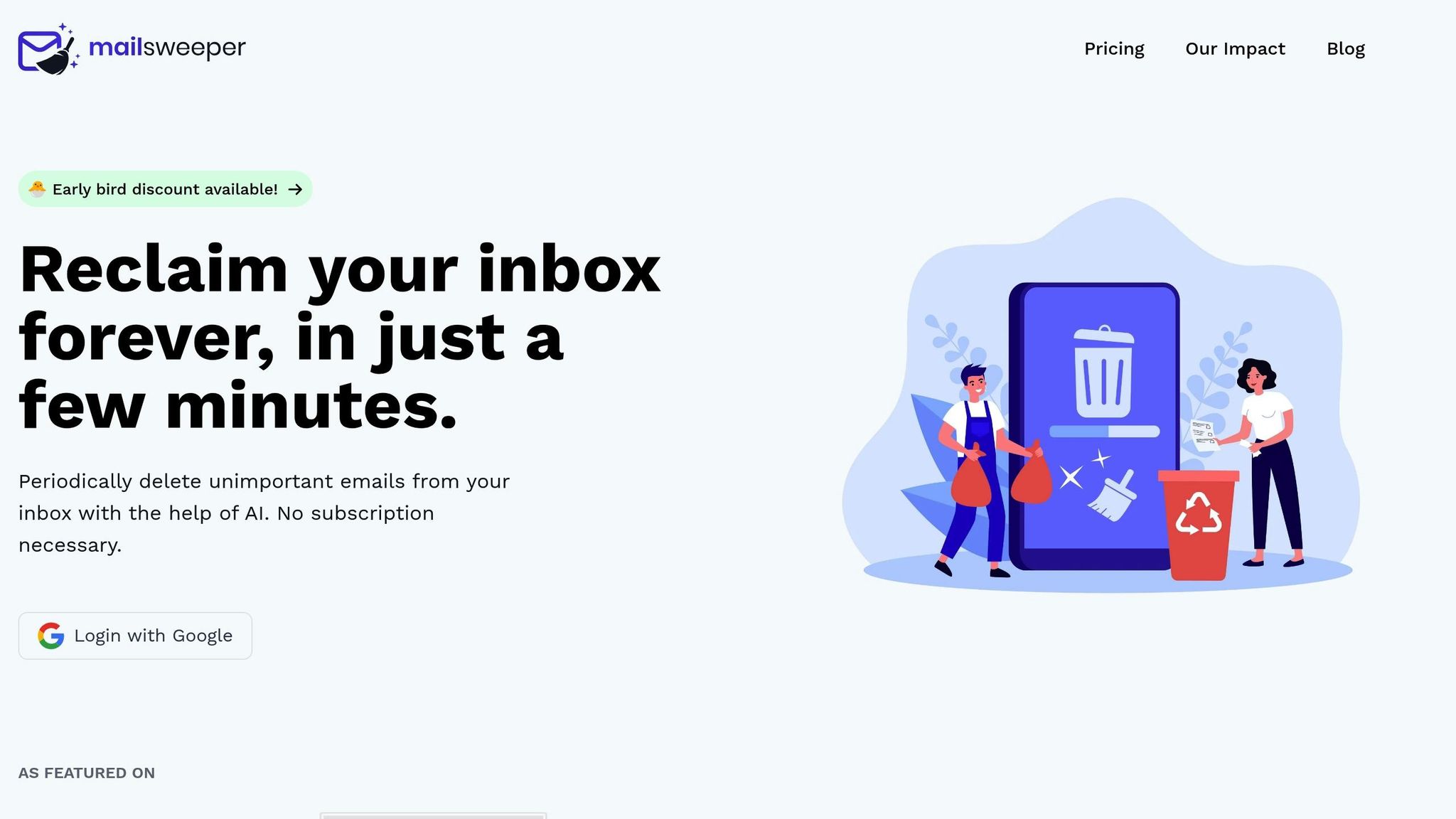Email Management
Mailsweeper vs. Fyxer
Explore how two email management tools tackle inbox overload with unique features, pricing models, and privacy measures tailored for different users.

Mailsweeper vs. Fyxer
Struggling with email overload? Whether it’s hitting Gmail’s 15 GB limit or managing high email volumes, tools like Mailsweeper and Fyxer offer two distinct solutions.
- Mailsweeper: A one-time purchase tool ($13–$20) that cleans up Gmail storage by automatically deleting unnecessary emails while prioritizing privacy.
- Fyxer: A subscription-based AI assistant ($8.99–$39.99/month) designed for professionals, offering advanced email organization, drafting, and task integrations.
Quick Comparison
| Feature | Mailsweeper | Fyxer |
|---|---|---|
| Cost | One-time payment ($13–$20) | Subscription ($8.99–$39.99/month) |
| Focus | Gmail storage cleanup | Advanced email management |
| Privacy | CASA certified, no data storage | Enterprise-grade security |
| Setup | Quick, Google-only integration | Supports multiple platforms |
| Best For | Individuals clearing Gmail storage | Professionals managing large email volumes |
If you need to free up Gmail space affordably, choose Mailsweeper. For a feature-rich assistant that handles complex tasks, Fyxer is your go-to.
Mailbutler vs SaneBox: Which Cleans Your Inbox Faster?

Mailsweeper: Features, Pricing, and Benefits

Mailsweeper offers a simple way to take control of your Gmail inbox, keeping it clean and organized while safeguarding your privacy.
This tool automatically identifies and removes unnecessary emails, making email management effortless.
Key Features of Mailsweeper
Mailsweeper scans your Gmail account to pinpoint emails that clutter your inbox. It uses smart analysis to understand your email habits and determine which messages are most relevant to you.
The tool is highly customizable, allowing you to train it on what to keep and what to discard. Unwanted emails are periodically moved to a "Dustpan", where you can easily restore them if needed.
Mailsweeper integrates seamlessly with your Google account and prioritizes privacy. It’s CASA certified and employs an intelligent preservation system to ensure important emails are never lost. By keeping your inbox tidy, it can also help you avoid paying for extra Google storage ($1.99/month for 100 GB or $2.99/month for 200 GB).
Another bonus? By cutting down on unnecessary emails, Mailsweeper helps reduce digital clutter.
Mailsweeper Pricing and Plans
Mailsweeper uses a one-time payment model, giving you lifetime access without recurring fees. Here’s a breakdown of the pricing options, including early adopter discounts:
| Plan | Price | Availability | Features |
|---|---|---|---|
| Very Early Bird | $13 (one-time) | Sold Out | Full AI email cleaning, lifetime access |
| Early Bird | $16 (one-time) | Limited (3 left) | Full AI email cleaning, lifetime access |
| Personal | $20 (one-time) | Available | Full AI email cleaning, lifetime access |
"The one-time payment option for lifetime access is refreshing and saved me from recurring fees - which I appreciate in today's subscription-heavy world."
– Stefan, Founder of Automateed
With straightforward pricing, it’s easy to choose the plan that works best for you.
Mailsweeper Setup and Privacy
Getting started with Mailsweeper is quick and easy. Just sign in with your Google account, make a one-time purchase, and answer a few simple questions. The entire setup takes less than five minutes. Once installed, Mailsweeper works quietly in the background, continuously decluttering your inbox and freeing up storage space.
Privacy is a top priority for Mailsweeper. The tool is Privacy Certified, meaning it doesn’t read or store your email content. Your personal communications remain completely secure while you enjoy a cleaner, more organized inbox.
Fyxer: Features, Pricing, and Benefits

While Mailsweeper focuses on decluttering your inbox to save space, Fyxer takes things a step further by enhancing productivity for users who deal with high email volumes. Its standout feature? Automating email categorization to keep your inbox neat and manageable.
Fyxer’s primary focus is email workflow automation, making it a go-to choice for professionals handling large amounts of business emails or requiring advanced sorting tools. Let’s break down what makes Fyxer tick.
Key Features of Fyxer
The backbone of Fyxer is its automated email categorization system. It smartly organizes incoming emails into categories like newsletters, promotions, social notifications, and priorities. Using adaptive filtering and custom workflows, the platform learns from your email habits, improving over time.
For bulk email management, Fyxer groups related messages, making it easy to archive or label them in one go.
Another highlight is its integration with popular productivity tools like Slack, Trello, and Asana. This means you can automate tasks like creating to-dos, sending team notifications, or updating project boards directly from your emails - no manual copying or pasting required.
Fyxer Pricing and Cost Structure
Fyxer offers a subscription-based pricing model with three main tiers, designed to meet different user needs.
- Basic Plan: At $8.99 per month, this plan includes automated categorization for up to 1,000 emails per month, basic filtering rules, and standard support. It’s ideal for individual users with moderate email activity.
- Professional Plan: For $19.99 per month, this tier supports up to 5,000 emails monthly and offers advanced automation workflows, third-party app integrations, priority support, and custom categorization. It’s a solid choice for small business owners and freelancers.
- Enterprise Plan: Priced at $39.99 per month, this plan handles unlimited emails and includes team collaboration tools, advanced analytics, API access, and dedicated account management. It’s tailored for larger organizations looking to streamline email management across teams.
Each plan comes with a 14-day free trial, so you can test the platform before committing. Plus, annual billing offers a 20% discount, bringing the monthly costs down to $7.19, $15.99, and $31.99 for the Basic, Professional, and Enterprise plans, respectively.
Fyxer Setup and Privacy
Setting up Fyxer is straightforward. You can connect your Gmail account via OAuth in about 10–15 minutes. During the initial setup, you’ll configure categories, establish basic automation rules, and train the AI using your existing email patterns.
The AI adapts to your email habits within a week, using your feedback to refine its performance. While this training phase requires some effort, it ensures more accurate categorization compared to plug-and-play solutions.
On the privacy front, Fyxer adheres to standard practices. It employs SSL encryption and secure storage to protect your data. The platform analyzes email metadata and content patterns for categorization but doesn’t prominently disclose details about data retention or third-party sharing in its public documentation.
For added control, Fyxer allows users to export their automation rules and category settings. However, access to these features ends immediately if your subscription lapses, unlike platforms offering lifetime access options.
sbb-itb-34b9fd2
Mailsweeper vs. Fyxer: Side-by-Side Comparison
Now that we've broken down the features of each tool, let’s see how they stack up against each other in the world of email management.
Comparison Table
| Feature | Mailsweeper | Fyxer |
|---|---|---|
| Primary Focus | Gmail storage optimization via AI cleanup | Email cleanup through a subscription model |
| Pricing Model | One-time payment ($13–$20) | Tiered subscription plans |
| AI Capabilities | Automatically identifies and deletes unimportant emails | AI-driven email cleanup |
| Storage Benefits | Reduces Gmail storage by deleting emails promptly | N/A |
| Setup Integration | Quick Google account integration | N/A |
| Privacy | CASA certified for data privacy | N/A |
| Long-term Cost | One-time lifetime payment | Recurring subscription fees |
| Customization | Customizable email cleaning preferences | N/A |
| Team Features | Designed for individual use | N/A |
Key Differences Analysis
The table highlights some important distinctions, so let’s break them down further.
Cost is one of the most noticeable differences. Mailsweeper charges a one-time fee, making it a budget-friendly choice for long-term use. In contrast, Fyxer’s subscription model means ongoing expenses that can add up over time. If you're aiming to stick to a single payment, Mailsweeper might be the better fit.
When it comes to functionality, Mailsweeper focuses on Gmail storage optimization, automatically clearing out unnecessary emails to free up space. This makes it particularly useful for users dealing with Gmail's storage limits. On the other hand, Fyxer delivers its email cleanup services through subscription tiers, which may cater to varying needs but lacks the direct storage benefits of Mailsweeper.
Integration and ease of use are also worth noting. Mailsweeper integrates seamlessly with Google accounts, allowing users to start cleaning up their inbox almost instantly. Fyxer doesn’t offer the same level of integration simplicity.
Privacy is another area where Mailsweeper stands out, thanks to its CASA certification, ensuring secure data handling. Fyxer does not provide similar privacy assurances, which may be a deciding factor for users concerned about data security.
Finally, scalability plays a role in choosing between the two. Mailsweeper’s flat-rate pricing is ideal for individuals or small teams looking for consistent email cleanup without recurring costs. Fyxer’s subscription plans, however, may appeal to businesses that need more flexibility and are willing to pay for it.
Ultimately, the choice comes down to your specific email management needs, budget, and whether you prioritize one-time payments or ongoing features. Both tools offer unique approaches to keeping your inbox under control.
How to Choose Between Mailsweeper and Fyxer
Now that we've covered the features and pricing of both tools, it's time to think about which one fits your needs best. The right choice depends on your specific goals, budget, and how much you value privacy.
Factors to Consider
Start by identifying your main goal. Are you looking to free up Gmail storage space or do you need a tool to handle more complex inbox tasks? If your focus is on clearing up storage and avoiding those annoying "storage full" notifications, Mailsweeper is a solid choice. It specializes in identifying and deleting unnecessary emails. On the other hand, if you want an all-in-one assistant that can organize your inbox, draft replies, summarize email threads, and even help with scheduling, Fyxer is the better option.
Think about your budget. Mailsweeper charges a one-time fee (ranging from $13 to $20) for lifetime access, making it a cost-effective solution. Fyxer, however, operates on a subscription model, which can add up over time.
Privacy matters, too. Mailsweeper takes a hands-off approach by not storing or reading your emails and is certified by CASA. Fyxer, meanwhile, offers a range of enterprise-level certifications, including ISO 27001, SOC 2 Type 2, GDPR, and HIPAA compliance. If you prefer minimal data handling, Mailsweeper is the safer bet. But if you need robust security for compliance or sensitive data, Fyxer's certifications provide peace of mind.
Consider integration needs. If you're using platforms beyond Gmail, such as Outlook, Fyxer supports them. Mailsweeper, however, is designed exclusively for Google accounts.
Ease of use is another factor. Mailsweeper is straightforward to set up and runs quietly in the background. In contrast, Fyxer offers advanced features like drafting replies and suggesting meeting times, but it may take some time to get used to its more complex interface.
By weighing these considerations, you can align each tool's features with what you need most.
Recommendations by User Type
Here’s how different types of users can decide between Mailsweeper and Fyxer:
- Students and budget-conscious users: Mailsweeper is ideal with its one-time payment and simple setup, offering years of email cleanup without ongoing costs.
- Busy professionals: Fyxer’s AI-driven tools are perfect for managing emails, drafting responses, and coordinating schedules efficiently.
- Small business owners: Mailsweeper provides predictable pricing for managing storage across multiple accounts, while Fyxer’s subscription is worth it for businesses needing AI-powered communication tools.
- Privacy-focused users: Mailsweeper’s minimalist data handling and CASA certification suit those prioritizing privacy, whereas Fyxer’s enterprise-grade certifications cater to regulated industries.
- Power users: If you want a feature-packed solution, Fyxer delivers advanced functionality. But if your main goal is efficient inbox cleanup, Mailsweeper’s streamlined approach is the better match.
Ultimately, the best tool depends on how well its strengths align with your email management needs.
Conclusion
Picking the right email management tool can greatly impact your productivity and help you manage storage costs more effectively. Both Mailsweeper and Fyxer offer distinct solutions to address inbox overload.
- Mailsweeper stands out with its one-time payment plan (ranging from $13 to $20). It’s perfect for solving Gmail storage issues while maintaining privacy, thanks to its CASA certification.
- Fyxer, on the other hand, offers a subscription-based service that doubles as a full-fledged AI email assistant. From drafting and scheduling to sorting emails, it’s designed to streamline workflows for professionals who manage high email volumes.
Ultimately, your decision boils down to your priorities. If reducing storage costs is your main concern, Mailsweeper is a smart choice. But if you’re looking for a tool to manage your emails efficiently while saving time, Fyxer is worth considering.
With the demand for AI-powered email tools on the rise, these solutions are becoming essential for staying productive in today’s fast-paced world. Choose the one that fits your needs and take control of your inbox!
FAQs
How does Mailsweeper protect my privacy and keep my data secure when managing emails?
Mailsweeper puts privacy and data security front and center. It employs advanced encryption protocols to keep your emails and personal information safe during processing. On top of that, it adheres to industry-standard security practices and regulations, offering strong protection against unauthorized access or potential breaches.
What sets Mailsweeper apart is its strict privacy policies. Your email content is never shared or used for anything beyond its core purpose - cleaning up your inbox and optimizing storage. This focus on security lets you enjoy a more organized inbox without worrying about your data's safety.
What sets Mailsweeper's one-time payment model apart from subscription-based services like Fyxer?
We’re here to focus on Mailsweeper’s features and what it brings to the table, so we won’t dive into a direct comparison with Fyxer’s subscription model. If you’re curious about Mailsweeper’s pricing or functionality, check out the detailed sections of our blog for more information.
Which tool is better for managing a large volume of business emails, Mailsweeper or Fyxer?
The article dives into a side-by-side comparison of Mailsweeper and Fyxer, examining their features, performance, pricing, and overall usability. Both tools aim to streamline messy inboxes and improve Gmail storage management. However, it stops short of declaring a clear winner for managing large volumes of business emails. Instead, it provides valuable insights to guide your choice based on what works best for your specific needs and priorities.
